Rochester Drug Cooperative: Robots ready for work
It’s still early stages, but Rochester Drug Cooperative is proving that mobile robotic piece picking can get the job done in the right application.
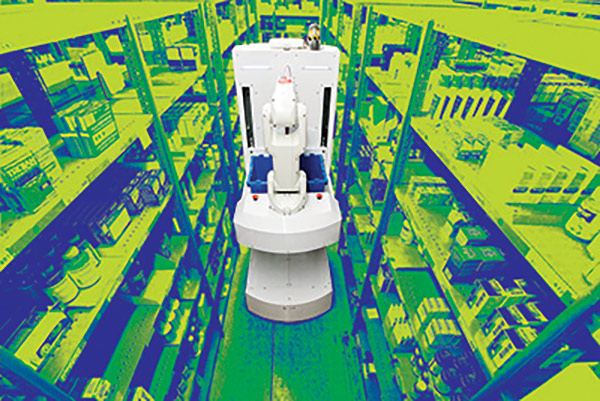
Up on a 19,000-square-foot mezzanine in a distribution center in western New York, order selectors at either end of a pick module are directed by voice as they walk through their zones, picking slow-moving SKUs.
There’s nothing special about that process at the Rochester Drug Cooperative, which goes to market as RDC. It’s the kind of piece-picking solution you see every day in distribution centers. But in the middle of the pick module, something different is happening. Dubbed “Adam” because it’s a first of its kind, a mobile piece-picking robot (IAM Robotics) picks from 1,200 SKUs stored on static shelves in a four-aisle pick zone.
View the in depth system report for the Rochester Drug Cooperative’s new distribution center here.
When a shipping tote representing a store order for one of RDC’s independent pharmacy members is conveyed into the robot’s work zone, Mike Collins, the robotic operator, scans a bar code to send picking instructions to Adam. The robot then travels autonomously through the zone, using an arm with a suction cup to pick items to a tote. When the order has been picked complete, the robot travels back to Collins. He scans the items into the shipping container, pushes it onto a takeaway conveyor and scans the next shipping tote to initiate the next order. Asked whether the robot is accurate and reliable, Collins chuckles: “The highlight of my night is when it misses something,” he says. Which, isn’t very often. While the robot was working four aisles during a July visit, RDC was prepping an adjoining zone that would double the size of the robot’s area.
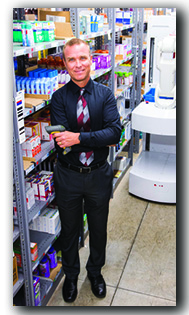
Gary Ritzmann, project manager |
While an early prototype of Adam picked 1,100 items an hour stationed in front of a shelf in IAM Robotics’ test area, this robot is picking between 100 and 110 items an hour, a rate that is similar to human order selectors working the mezzanine. Whether the robot can work faster—the robot maker estimates that at speed it could make as many as 400 picks an hour—is moot, according to Gary Ritzmann, the Rochester Drug project manager who oversaw the implementation of the robot and an industry veteran. The current rate is all that’s required for the application.
“Downstairs on the floor, our order selectors do between 250 and 300 picks per hour from fast-moving items in carton flow racks,” Ritzmann says. “But upstairs, where we store our slowest-moving items, the robot is only picking three hours a night. Our order selectors need to pick about 100 lines per hour to get their work done, and the robot has no problem keeping up.”
The robot went into production in January 2017 and picked test orders until March. Seven months in, Ritzmann says RDC is still learning how to get the most out of the application. At present, the robot is between 95% and 98% accurate, compared to 99.9% accuracy for voice-directed associates. “But most of the errors can be eliminated if we do a better job of putting product away on the shelf correctly,” Ritzmann says. He adds that if the next steps they have planned to integrate the robots further into the automation system pan out, RDC plans to expand the fleet to four robots. “I’m convinced it’s going to work,” he says.
The dynamics that convinced RDC to take a chance on a new, emerging technology, as well as the cooperative’s methodical step-by-step approach to rolling out robotics, could very well provide a road map for other end users who are also thinking about becoming early adopters of robots.
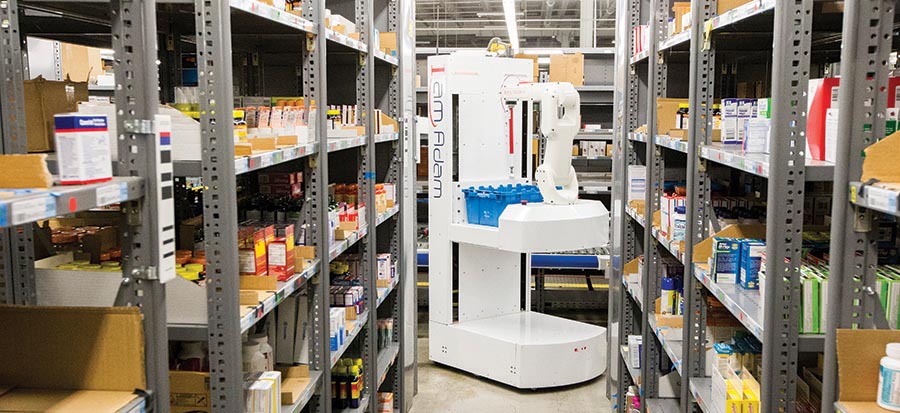
Adam, the mobile piece-picking robot, automatically picks slow moving items.
Early adoption
Let’s face it: It’s a pretty exciting time to be in the distribution business. Automation is old hat to manufacturers, but many retailers and distributors like Rochester Drug Cooperative have long gotten along adding more pick modules and throwing more people at the problem. After all, traditionally people were plentiful, flexible and relatively inexpensive when compared to automation. That was especially true in facilities with uneven demand.
For many, though, that old formula is no longer working. New customer and market demands, especially those related to e-commerce, have put a premium on getting every order accurate and complete, and doing so in record time to meet aggressive order cut-off times. At the same time, it’s harder than ever to find a reliable workforce, especially for two- and three-shift operations.
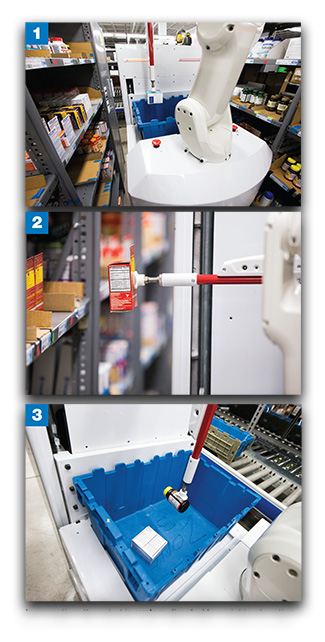
In operation, the robot is system directed to a picking location (1). Using a suction cup arm, the robot picks the required item (2). It then places it in a tote before the next pick (3). |
The result has been a slew of new automated offerings to solve the piece-picking and packing problem. In recent issues of Modern, we’ve featured shuttles and bots for goods-to-person picking at facilities operated by Destination Maternity and Johnson & Johnson Vision Care; pocket sorters at REI and Stage Stores; and mobile robots at Quiet Logistics and GE Healthcare. Many of those projects represent a first-time implementation of a technology or unique solutions by early adopters who were looking for an edge.
Count Rochester Drug Cooperative in that category. Founded in 1905, RDC describes itself as “a marriage of a traditional drug distribution company, a buying cooperative and a private long-term investment structure formed for the sole benefit of pharmacist-entreprenuers.”
With more than $2 billion a year in sales, RDC provides pharmaceuticals, over-the-counter health and beauty care products, and health care supplies to more than 1,300 independently owned community retail pharmacies, long-term care pharmacies and home health care stores in the Northeast. It currently ranks as the seventh-largest full-line distributor in the United States. In this industry, RDC’s top three competitors control more than 90% of the market. Customer service is paramount—all orders are delivered next day.
RDC did not set out to become an early adopter. As recently as five or six years ago, the Rochester facility was relatively light on automation—a conveyor and voice technology. But, with business growing, labor was becoming an issue, especially on the second shift, which operates from 5:30 p.m. till 2:00 a.m. At the time, the facility was processing about 30,000 lines a night with a crew of 45 people. The slow-moving SKUs on the mezzanine were the hardest to pick.
“It was a hectic work environment, and we had a lot of turnover,” says Joe Brennan, who has been with RDC for 25 years and recently became CEO. Or, as Larry Doud, Brennan’s predecessor, explained to Modern back in 2015: “Too often, people are scheduled to work and don’t show up, or go out for a meal and don’t come back.” Turnover was as high as 40% a year.
To address the issue, RDC considered expanding the Rochester operation. Instead, it opted to build a new, highly automated 110,00-square-foot automated facility in Fairfield, N.J., since more than 60% of the cooperative’s business is in the New York metropolitan area. That facility, developed with SSI Schaefer, represented RDC’s first leap into automation, with A-frames, carousels and other automation. The new facility took some of the pressure off the Rochester facility. It also provided a window into the benefits of automation. Yet, the second shift continued to experience constant turnover.
What happened next was as much a matter of coincidence as design. As Doud, the former CEO, told the story to Modern back in 2015, he shared his frustration with one of RDC’s pharmacist customers and said something like: “Someone ought to invent a robot.” As it turned out, Tom Galluzo, the pharmacist’s son, was a robot specialist at Carnegie Mellon University in Pittsburgh and the co-founder of IAM Robotics.
While materials handling wasn’t necessarily top of mind for Galluzzo, he went to Rochester to learn about the picking process for slow-moving SKUs. In the spring of 2014, he made a pitch. “He asked us if we could get something that could pick two to three times faster than our current pickers and work multiple shifts without a break or vacation, would we be interested,” Ritzmann says. “Well, of course!”
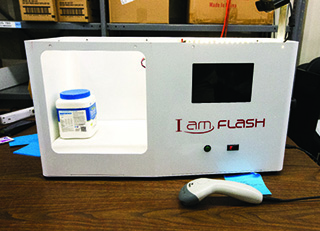
RDC’s robotics supplier developed a high-speed cubing and weighing device to capture and manage information about the products picked by the robot. |
Over the next six months, Ritzmann and IAM Robotics worked together to better understand just what a robot would have to do to integrate with RDC’s operation. At one point, RDC sent IAM about 20 common SKUs to practice on. In November 2014, right before Thanksgiving, a prototype was ready for a demonstration.
To get ready, Ritzmann prepped a test area with about 60 items. They were stored next to one another on a limited number of shelves in one aisle. The prototype showed up on a Thursday afternoon. A team from IAM Robotics uncrated it, put it together and ran some tests. “The next day, we were picking,” Ritzmann says.
The prototype had limited capabilities, and the picking demonstration was similarly limited, but in that environment, the robot did what it was supposed to do. RDC decided to go to the next step.
Next steps
There was risk-taking on everyone’s part, which meant that part of the next step was a contract, with RDC providing some funding for Beta model of the robot. Those were corporate issues. From Ritzmann’s point of view, there were operational issues to get the robot ready for prime time.
For one, the prototype had limited maneuverability. It moved up and down aisles, but it couldn’t turn corners. To work in the pick module, it had to make 90-degree turns so it could access multiple aisles. The robot also needed a lift so the robotic arm could access a wider range of shelves. To enter new SKUs into the system, IAM Robotics developed a high-speed, 3D scanner that rapidly weighs and scans an item, creates a 3D model, classifies the new product and then enters it into the database of products being picked by the robot.
Speed was part of the discussion, but less of an issue given the application. While the roboticists estimated that the robot could pick as many as 400 pieces an hour and work the same pace at the end of the shift as at the beginning of the shift, for now, a robot only needed to pick 100 or so pieces an hour to meet RDC’s needs.
Of course, prototypes aren’t built in a day, and given that this was a new solution designed for RDC’s picking environment, this was no exception. By April 2016, however, a team from RDC traveled to Pittsburgh to watch a demonstration of the Beta robot. At that point, RDC gave the go ahead to build a production-ready robot. “We went back in September and approved what they’d built,” Ritzmann says.
IAM Robotics put the robot through its paces in Rochester, then took it back to Pittsburgh for tweaking, delivering the completed robot in late October. “We took a slow approach rolling it out,” Ritzmann says. “Rather than just going live, we used the robot intermittently during the day for test orders through the end of the year. They made tweaks and updates, and then we’d test again.”
By the end of the year, RDC was satisfied that the robot was ready to go into production on the mezzanine in January 2017, after the holidays.
Working with robots
Being an early adopter is no easy task. As Ritzmann puts it, “If it was easy, someone else would’ve already done it.” Rather than flip the switch last January, go live, and then install the other three robots, RDC has taken a “crawl to walk, walk to run, run to sprint” approach to minimize the risk of failure.
For the first several months, someone from IAM Robotics was on site to address any issues and to train Collins, the robot operator. Once Collins was self-sufficient, he began working on his own. Still, IAM Robotics gets real-time feedback from the Cloud that allows it to monitor the performance of the robots and report important metrics to RDC.
The robot was assigned to an area with four aisles and 1,200 SKUs. And, to get started, the robotic picking process mimics what order selectors are doing in the adjoining aisles. Collins scans new shipping containers when they arrive in the robot’s zone to initiate picks for that order, just like the nearby order selectors.
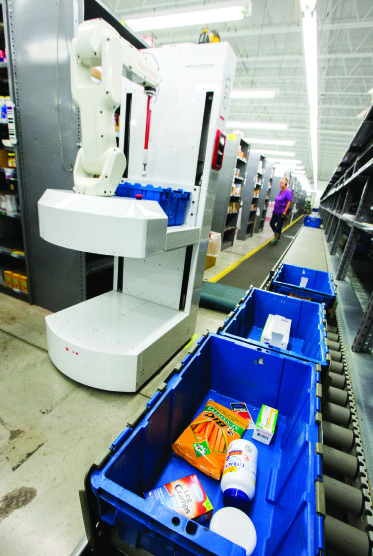
After picking, the robot delivers the items to a tote induction station. At present, picked items are placed in the shipping tote by an operator. |
The robot picks to an onboard tote as it travels through the pick zone; when the order is picked complete, Collins empties the contents into the shipping container and inducts it onto a take away conveyor. Similarly, order selectors pick to a lightweight carrier that they then dump into a shipping container and induct it onto the takeaway conveyor.
For now, Collins also scans the items to ensure accuracy before pushing the container onto the takeaway conveyor. “We don’t have to do that,” says Ritzmann. “But for now, we want to make sure that the order was picked accurately and complete. And, we’re doing it to keep statistics.”
Next steps are already on the drawing board. First, RDC is going to double the size of the robot’s pick zone. “If we’re able to do that successfully, we can double the number of orders the robot picks for and do batch picking,” Ritzmann says. In addition, RDC is working with SSI Schaefer to integrate the robot with the conveyor system. The idea is to have the shipping container automatically roll on and off the robot, freeing up Collins for other tasks. Assuming these ideas pan out, RDC plans to expand the fleet to four robot zones that could handle most of the slow-moving SKU picking on the second shift.
Having worked with the robot for six months, Ritzmann’s biggest surprise was the speed of the IT integration. “We’re piggy-backing off information we’re already sending to our voice system and the warehouse control system managing the conveyors,” he says. “Getting the information from our enterprise resource planning system to their server and from their server to the robot went better and faster than I imagined,” he says.
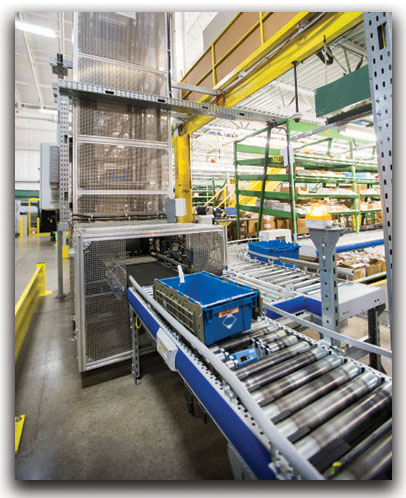
An automatic tote dispenser is one of the automated features of RDC’s Rochester facility. |
He has also learned that precision counts, as is the case with most automated equipment. Most of the robot’s mistakes are the result of how items were put away onto the shelving. “Those can be eliminated if we put things away correctly, which ought to be a best practice anyway,” he says.
He says other potential users call and ask if picking from static shelves is a limiting factor. Ritzmann points out that the robot was designed to pick from his static shelves—he doesn’t need robots to pick from case flow rack. While it is a niche solution, most automation is suited to specific applications. AGVs aren’t a replacement for all lift trucks; automated storage hasn’t replaced all pallet and pallet rack and shuttles; and pocket sorters have not yet made pick-to-light mezzanines obsolete. “I spent 15 years selling materials handling solutions,” he says. “There are thousands of warehouses with static shelving.”
There is more work to be done. It is after all, just one robot working three hours a shift during part of the week. But Ritzmann and Brennan believe that robots are ready for work today for those companies brave enough to be early adopters.
“We saw what automation could do for us when we opened the new DC in Fairfield, New Jersey,” says Brennan. “We all get that this is the so-called bleeding edge, but I think there will be rewards in the end.”
Ritzmann says robots will position the facility for the future. “Right now, we’re in 10 states and trying to expand the territory that we cover with this facility,” he says. “If we’re able to use a fleet of mobile robotic pickers, we can increase our business without having to bring on additional help, and, I think it acts as a motivator to the other order selectors.”

Article Topics
Equipment Report News & Resources
Radial stays ahead of the automation curve Wireless Mobility: Ready for the next leg up AGVs set new standards for inventory transportation Inside North Shore Care Supply: Bringing robots to receiving Bergen Logistics: Putting robots to work in a multi-tenant facility High-tech meets low-tech: Automate storage for pallet loads Tuggers, carts work together to increase productivity and ergonomics More Equipment ReportLatest in Materials Handling
Registration open for Pack Expo International 2024 Walmart chooses Swisslog AS/RS and software for third milk processing facility NetLogistik partners with Vuzix subsidiary Moviynt to offer mobility solutions for warehouses Materials Handling Robotics: The new world of heterogeneous robotic integration BSLBATT is looking for new distributors and resellers worldwide Lucas Watson appointed CSO for Körber’s Parcel Logistics business in North America Hyster recognizes Dealers of Distinction for 2023 More Materials HandlingAbout the Author
Subscribe to Materials Handling Magazine

Find out what the world's most innovative companies are doing to improve productivity in their plants and distribution centers.
Start your FREE subscription today.
April 2024 Modern Materials Handling

Latest Resources










